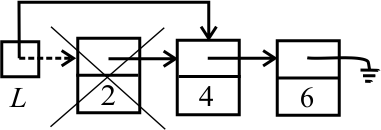34C. Example: Remove a Value from a Linked List
Suppose that remove(x, L) is intended
to be a destructive
function that removes the first occurrence
of x from list L, or does nothing if x
does not occur in L. For example, if
L is [2, 4, 2, 4, 5] and you perform
remove(4, L), then L is changed to
[2, 2, 4, 5]. The cases are as follows.
If L is empty, do nothing, since
x obviously does not occur in L.
-
If L is nonempty and the head of L
is equal to x, then set L to its tail.
However, the cell that contains x is
presumably no longer needed.
So it should be deleted. Look at how it needs
to work when L is [2, 4, 6] and x is 2.
If L is not empty and its head is not equal
to x, then remove x from the
tail of L.
Expressing that in C++ yields the following definition
of remove. In the second case, we need to be careful
manipulating pointers to avoid cutting the branch out from
under ourselves.
void remove(int x, ListCell*& L)
{
if(L != NULL))
{
if(L->head == x)
{
ListCell* p = L;
L = L->tail;
delete p;
}
else
{
remove(x, L->tail))
}
}
}
